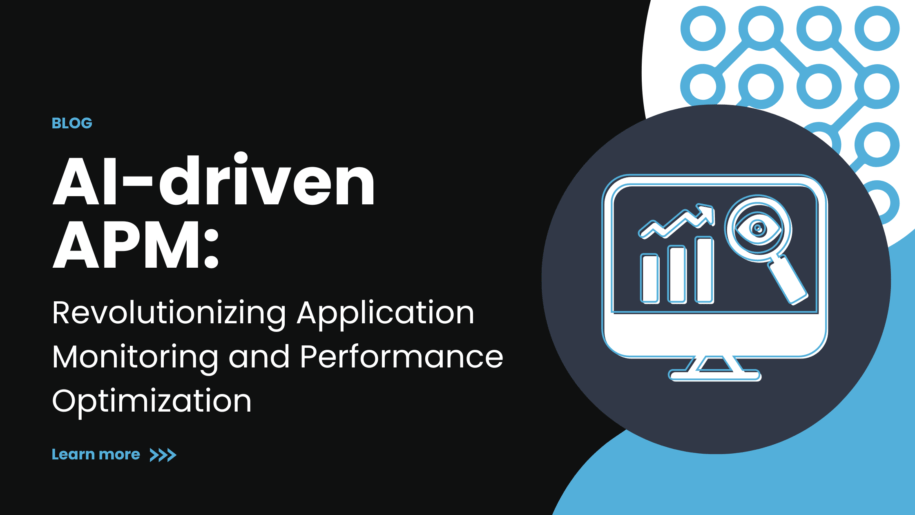The landscape of application performance monitoring (APM) is undergoing a profound transformation, driven by the integration of artificial intelligence (AI) and machine learning (ML) technologies. This evolution is reshaping how organizations approach application monitoring, troubleshooting, and optimization.
Traditional APM tools have long provided valuable insights into application performance, but they often require significant human intervention to interpret data and identify issues. AI-driven APM solutions are changing this paradigm by offering more intelligent, proactive, and automated approaches to performance management.
Key advancements:
- Anomaly detection: AI algorithms can analyze vast amounts of performance data in real-time, detecting subtle anomalies that might escape human notice. This capability allows for earlier identification of potential issues before they impact end-users.
- Predictive analytics: By leveraging historical data and machine learning models, AI-driven APM can forecast future performance trends and potential bottlenecks. This foresight enables proactive optimization and capacity planning.
- Root Cause analysis: AI can quickly sift through complex, interconnected systems to pinpoint the root cause of performance issues. This dramatically reduces mean time to resolution (MTTR) and minimizes the impact of outages.
- Automated remediation: Some advanced AI-driven APM solutions can automatically implement fixes for common issues, reducing the need for human intervention and ensuring faster problem resolution.
- Natural Language Processing (NLP): NLP capabilities allow for more intuitive interactions with APM tools, enabling users to query performance data using plain language and receive insights in easily understandable formats.
- Contextual intelligence: AI can correlate performance data with business metrics, providing a more holistic view of how application performance impacts overall business outcomes.
Implications for organizations:
- Improved efficiency: AI-driven APM reduces the manual effort required for monitoring and troubleshooting, allowing IT teams to focus on more strategic initiatives.
- Enhanced user experience: By identifying and resolving issues more quickly—often before users notice—AI-driven APM helps maintain high levels of application performance and user satisfaction.
- Cost optimization: Predictive capabilities enable better resource allocation and capacity planning, potentially reducing infrastructure costs.
- Scalability: AI-driven solutions can more effectively handle the increasing complexity and scale of modern applications, including microservices architectures and cloud-native environments.
- Continuous improvement: Machine learning models can continuously learn from new data, improving their accuracy and effectiveness over time.
Challenges and considerations:
- Data quality: The effectiveness of AI-driven APM relies heavily on the quality and comprehensiveness of the data it analyzes. Organizations must ensure they have robust data collection practices in place.
- Integration: Implementing AI-driven APM may require integration with existing tools and processes, which can be complex in some environments.
- Skills gap: Leveraging the full potential of AI-driven APM may require new skills within IT teams, potentially necessitating training or new hires.
- Explainability: Some AI models can be “black boxes,” making it challenging to understand how they arrive at certain conclusions. This lack of transparency can be a concern in critical applications.
- Privacy and security: As AI-driven APM systems process vast amounts of data, organizations must ensure they comply with data protection regulations and maintain robust security measures.
Looking ahead:
The future of AI-driven APM is likely to see even greater advancements. We can expect to see more sophisticated predictive capabilities, increased automation in both problem detection and resolution, and deeper integration with DevOps practices. As AI continues to evolve, APM tools will become even more proactive, potentially shifting from reactive monitoring to predictive and prescriptive optimization.
Why Choose FusionReactor APM:
In the landscape of AI-driven APM solutions, FusionReactor stands out as a powerful and innovative option. FusionReactor’s advanced Anomaly Detection capabilities leverage machine learning algorithms to establish baseline performance metrics and swiftly identify deviations from normal patterns. This proactive approach allows development and operations teams to address potential issues before they escalate into critical problems. Furthermore, FusionReactor’s OpsPilot feature takes automation to the next level. OpsPilot acts as an AI-driven assistant, continuously monitoring application performance and automatically implementing optimizations and fixes for common issues. This not only reduces the manual workload on IT teams but also ensures rapid response to performance fluctuations, maintaining high levels of application reliability and user satisfaction. By combining robust anomaly detection with intelligent, automated remediation, FusionReactor APM exemplifies the transformative potential of AI in application performance management, offering organizations a comprehensive solution for maintaining peak application performance in complex, dynamic environments.
In conclusion, AI-driven APM represents a significant leap forward in application performance management. By harnessing the power of AI and machine learning, organizations can achieve unprecedented levels of insight, efficiency, and proactive management in their application environments. As these technologies continue to mature, they will play an increasingly crucial role in ensuring optimal application performance and, ultimately, business success in the digital age.










